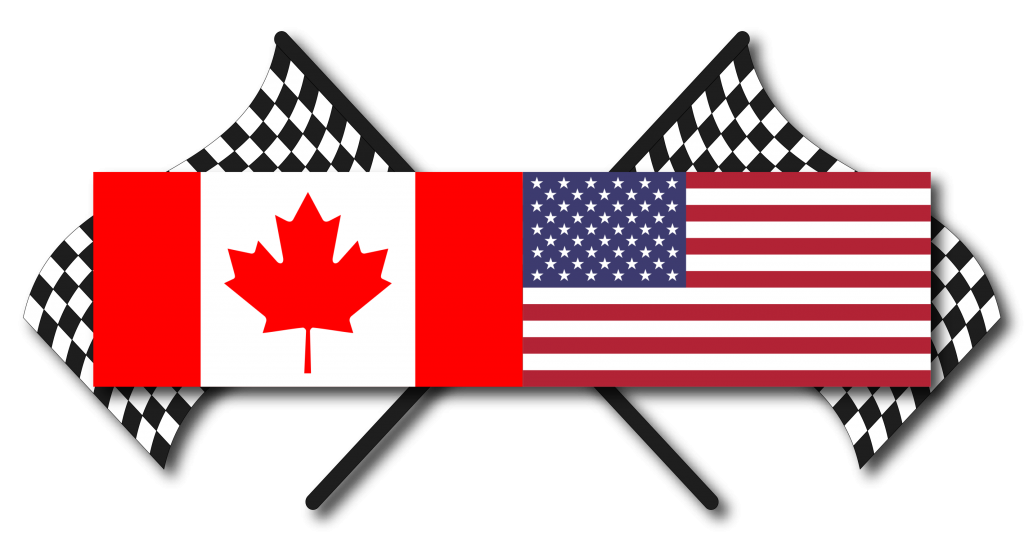

Stock Car Racing December 1977 – by John Hill
“THERE IS THE NATIONAL FLAG. He must be cold, indeed, who can look upon its folds rippling in the breeze without Pride of Country. If in a foreign land, the flag is companionship, and country itself, with all its endearments”
Charles Sumner said that in 1867 and the multitudes of Canadians who annually trek to America to witness Oswego Speedway’s International 200 probably would have said, “Right on, man, right on!”
For their hero of hero’s in the rugged game of supermodified racing, Warren Coniam of Mississauga, Ontario, came away with the victory in the closing moments of the $55,000 race when he was far behind in second place.
And if sometimes some wonder about the patriotism of some Americans, they should have seen the effect Coniam’s victory had on those North of the border when, “Hail to the Queen” was played to the assemblage in victory circle.
It didn’t start there. In fact when the American and Canadian National Anthems rang out before the start of the to the 15,000 fans gathered, some Canadians stood on the track by Coniam’s third place starting McKnight roadster holding aloft a huge flag with the maple leaf in red and white.
That gesture would be looked upon as the omen as to who would win.
The 21st edition of the richest supermodified race in the world was a survival of the fittest of the unfit. The first four cars finishing the race were all experiencing trouble.
Winner Coniam had a broken “Watts” link, (rear axle locator), runner up and defending champion Steve Gioia had the same problem, Jim Winks and Jim Shampine were both fighting badly worn right front tires while taking third and fourth places.
But the guy who had the healthiest car and seeming victory in sight, Kempton Dates, of Red Creek, N.Y., was slowly rolling into the pits – sans the life blood of race cars – fuel.
When I saw Kemp slowing ahead of me I said to myself, “We got’er won” related a happy Coniam after the race.
“I didn’t think it was going to happen,” he confessed. “We were running easy when on about the 160th lap that link broke and upset the cars handling. At first I thought I should park it but then I found the rear end was jammed against the frame . So, I just tried to hold on and finish”.
In the meantime, Dates, who had built Coniam’s car last winter, had been enjoying the front spot since the 99th circuit and was picking up $25 every time he circled the five-eights mile asphalt oval.
But then things began to happen on the 189th lap, Dave McKnight, owner of Coniam’s chevy engined roadster tell it like this, “Our engine builder, Doug Jones suddenly noticed Kemps exhaust flame change from blue to an orange color. Doug knew Kemp was beginning to get low on fuel so Doug madly began to wave Warren on,” McKnight said.
“I stayed right in there hoping I could finish,” related Dates later. “I had found before that I could go about 10 laps more when the car began to get low, but it didn’t happen this time”.
It sure didn’t, a Dates crewman said later that the pickup line had sucked the rubber bladder of the tank to the opening trying to help its driver get home.
With four laps remaining, Coniam limped into the lead as the McKnight crew, pitted beside that of Dates’, jumped for joy. Only long faces and sloped shoulders showed in the neighbouring pit.
The victory was a fitting climax for both Coniam and McKnight. It was the latter’s first year as a car owner. A long time supermodified follower. McKnight has in the past been too busy with his Toronto based trucking firm to become involved as a car owner.
“We do three million dollars a year in business”, he says, “but I had John Spencer complete the car originally for my son. Spencer drove it for a time but when Warren wrecked his own car in early season, I had him take over the driving”.
McKnight keeps the car in one of his truck garages and employs Jones to work on the car full time. In 11 weeks of racing Coniam and McKnight have won six features, scored five seconds and earned $11,500 from just the Classic alone. And they are not through winning yet in the northeast.
For several others, the Classic weekend was rough.
The night before, in the Modified Sportsman 200, Jimmy Shampine was going by Dean Hoag for second place in late race when Hoag’s rear axle broke. Shampine went over the nose of Hoag’s car and into the wall. In the meantime, Richie Evans cruised to his first “200” victory.
During the Classic on Sunday, Shampine’s record setting (17.928 sec.) new roadster had a fuel pump fail after only eight (Jimmy’s car number) laps. During a red flag stop to clean up an accident, Maynard Troyer, driving Jimmy’s back up roadster, fairly pleaded with his car owner to take over the driving so he, Troyer, could go to nearby Fulton Raceway to try to make a Modified 100 lap race with his awaiting Nagle Pinto.
Shampine agreed as Troyer hopped the first turn wall in his haste to get to Fulton. He missed the show.
Four drivers took trips to the hospital, Jack Hopkins rolled his ex-Indy roadster off a steel wall and landed inverted collapsing the cage. He broke his left arm in 15 places.
Del Meeks, in another sturdy Dates built car, climbed the rear of another at peak speed flipping end over end down the front chute and into the first turn. Broken ribs for him.
Former USAC racer, Gary Albritain pounded the wall in Ed Bowley’s racer, rang his bell and spent two days in the crash house waiting for the buzzing to stop. Jeff Stevens received a whiplash when his sprint-roadster half spun and nailed an inside hub rail.
Bentley Warren had Dave Snyder’s potent roadster in third place until his rear gears shed their teeth . . . Ageless, six time Classic Champion, Nolan Swift, spent most of the season getting his new, light weight roadster to handle, just at the 11th hour and came from 31st starting to a seventh place finish . . . And veteran Mark Letcher, out of a two year retirement, drove Jack Tobin’s, Leffler build roadster to a $2,000 sixth place finish.
A “Classic” it was. Shampines recently debuted, lightweight, radically offset roadster (the engine is completely outside the cars chassis on the left) has sent many other owners to the design boards for 1978. It is change time again at Oswego.


